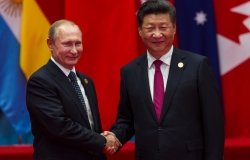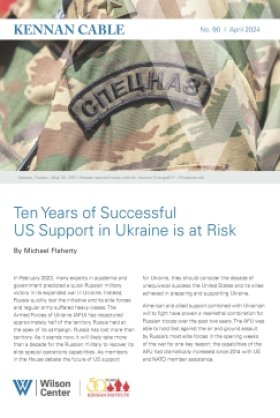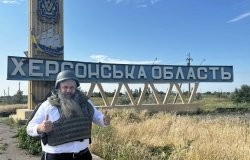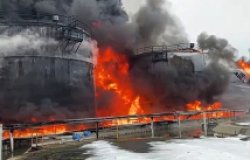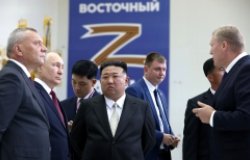The Chernobyl Nuclear Catastrophe 25 Years Later: What Have We Learned?
Nataliya Mironova, founder, Movement for Nuclear Safety, Chelyabinsk; Natalia Manzurova, Radiation Ecology Expert, "Planet of Hope," Chelyabinsk
Overview
The "Japanese government did not learn from the experience of the Chernobyl tragedy," said Natalia Mironova, founder, Movement for Nuclear Safety at a 29 March 2011 Kennan Institute event. Mironova stressed that the Chernobyl accident and the catastrophe at the at the Fukushima nuclear plant in Japan have a lot in common—particularly, the incidents both involved levels of government secrecy. Mironova was joined by Natalia Manzurova, Radiation Ecology Expert, "Planet of Hope," Chelyabinsk.
Mironova stressed the inherent dangers in relying on nuclear power. "Thirty eight nuclear accidents occurred in the world between 1945 and 1960," she said, "and 332 since 1960." Nevertheless, in Mironova words, the international nuclear lobby headed by the International Atomic Energy Agency (IAEA) advocates restrictions on the dissemination of nuclear information. The IAEA, for example, calls on governments to restrict the collection and publication of statistics related to nuclear energy production in the world. 
Mironova condemned such an approach and cited the Chernobyl disaster in supporting the need for greater openness. Government secrecy and the withholding of information about the radiation leaks led to significant human losses. "Approximately 510,000 personnel got exposed [to radiation] during Chernobyl, and no one can tell how many lives were lost since the time of the explosion." She noted that in 2011, the level of expected health damage from Chernobyl is 100 times higher than the estimate in 1986. "Children who were exposed to the Chernobyl fallout have been experiencing chronic diseases as adults related to their respiratory, digestive, nervous and cardiovascular systems, as well as internal organs. In 1991, the level of serious illness among children was about six to seven times above normal," Mironova said.
Japan's nuclear industry also has not exactly been renowned for openness and transparency. Mironova noted that Tepco (the owner of the Fukushima reactors) itself has been implicated in a series of cover-ups down the years. In 2002, the chairman and four other executives of the company resigned and were suspected of having falsified safety records. Further examples of falsification were identified in 2006 and 2007. She added that Fukushima leaks "will bring us more surprises," as the impact of radiation leaks will have long-term effects for people and environment.
Manzurova shared her personal memories of the Chernobyl disaster. She talked about the first time she arrived in Pripyat', a little Ukrainian town nearby Chernobyl, now famous as a ghost town. "We arrived there right after the catastrophe, and the first shock was that I didn't hear any sound—no human voices, no birds, nothing. People left the city practically without any necessities." She remembered that soldiers, who were ordered to help with "the clean-up," were sent to the reactor for one minute and then ran out due to the very high radiation level. Today it has been estimated that nearly 600,000 soldiers were exposed to radiation in Chernobyl.
 Manzurova agreed with Mironova about the importance of open information in the nuclear sphere. After the Chernobyl nuclear explosion, the USSR Ministry of Health decided to classify information about the accident; the results of treatment for injuries; and the extent of radiation damage to the personnel involved in the Chernobyl cleanup. Today, no one knows exactly how many people were affected. Talking about her colleagues who also took part in the clean-up in Chernobyl, Manzurova said that of all of them, only she remained alive.
Manzurova agreed with Mironova about the importance of open information in the nuclear sphere. After the Chernobyl nuclear explosion, the USSR Ministry of Health decided to classify information about the accident; the results of treatment for injuries; and the extent of radiation damage to the personnel involved in the Chernobyl cleanup. Today, no one knows exactly how many people were affected. Talking about her colleagues who also took part in the clean-up in Chernobyl, Manzurova said that of all of them, only she remained alive.
Mironova and Manzurova emphasized that the Fukushima nuclear tragedy is the latest symbol of the need to put an end to nuclear era, an era that is unsafe for humanity. Instead, we are witnessing the so-called "Nuclear Renaissance." As an example, the two experts cited the IAEA decision last December to create a global nuclear fuel bank in Russia as part of an international effort to curb the spread of nuclear arms to nations such as North Korea and Iran, while allowing nations to use low-enriched uranium for their energy needs. Mironova and Manzurova concluded that there is a great need to stop this "Nuclear Renaissance"—in particular, to halt the "lifetime extension" of nuclear plant practices; to stop the transfer of nuclear waste; and to make better use of energy alternatives.
By Nataliya Jensen
Blair Ruble, Director, Kennan Institute
Documents & Downloads
Speakers
Hosted By

Kennan Institute
The Kennan Institute is the premier US center for advanced research on Russia and Eurasia and the oldest and largest regional program at the Woodrow Wilson International Center for Scholars. The Kennan Institute is committed to improving American understanding of Russia, Ukraine, Central Asia, the Caucasus, and the surrounding region though research and exchange. Read more
Thank you for your interest in this event. Please send any feedback or questions to our Events staff.




